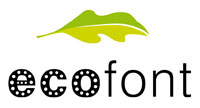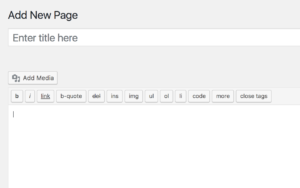 Dutch marketing company Spranq has figured out a clever way to save on ink: punch holes in the font. Their new Ecofont is a freely downloadable font that has a “Swiss-cheese design” intended to save ink by cutting down on the amount of printable area on each letter.
Dutch marketing company Spranq has figured out a clever way to save on ink: punch holes in the font. Their new Ecofont is a freely downloadable font that has a “Swiss-cheese design” intended to save ink by cutting down on the amount of printable area on each letter.
According to Spranq, they saw an average of 20% reduction in ink usage while using the Ecofont compared to that of the original source font, Bitstream Vera Sans. The font resembles the classic Verdana, riddled with donut holes. Spranq’s goal was to remove as much of the font as possible while still maintaining readability. After experimenting with several shapes, they landed on the hole approach, concluding that the basic shape of the letter needed to remain intact in order for the font to be usable.
The font is best used at size 9 or 10 and printed with a laser printer. Though it certainly isn’t crisp enough for public documents, Spranq thinks the Ecofont could be suitable for things like intra-office memos, employee handbooks, and other internal business documents, as well as for personal use.
The font is offered for free under an open source license that encourages contributions from outside developers. Already there are Arabic and Hebrew versions of the Ecofont under development that apply the same ink-saving principles.

Spranq says that the amount of ink saved when using the Ecofont will depend on the age and variety of the printer and the size of the font (the smaller the font, the smaller the percentage of ink savings — though smaller fonts also use less ink in general).
The Ecofont is a really neat idea that should save not only money, due to using less ink, but also help to save the environment by creating less waste (fewer discarded ink and toner cartridges). If you do a lot of printing, you should definitely considering putting the Ecofont into use as a method of saving money and creating less waste. We think Spranq has hit on something very cool and hope that it catches on.
Also be sure to check out our article 10 Tips for Being a Greener Web Designer for more environment saving tips.
Frequently Asked Questions about Ecofont
What is the main purpose of Ecofont?
Ecofont is designed with a primary goal of reducing ink usage, thereby saving costs and being environmentally friendly. It achieves this by using a unique design that includes small, circular holes in the characters. These holes are not visible to the naked eye when printed in regular font sizes, but they significantly reduce the amount of ink used.
How much ink can I save by using Ecofont?
The amount of ink saved by using Ecofont can vary depending on the specific document and printer settings. However, it is estimated that Ecofont can reduce ink usage by up to 20%. This can result in substantial savings over time, especially for businesses and individuals who print large volumes of documents.
Is Ecofont compatible with all types of printers?
Yes, Ecofont is designed to be compatible with all types of printers. It works by reducing the amount of ink used to print each character, regardless of the specific printer model or brand. However, the exact savings may vary depending on the printer’s efficiency and settings.
Can I use Ecofont for all types of documents?
Ecofont is versatile and can be used for a wide range of documents. However, it is most effective when used for text-heavy documents like reports, essays, and articles. For documents with a lot of images or graphics, the ink savings may be less noticeable.
How does Ecofont compare to other fonts in terms of readability?
Despite its unique design, Ecofont maintains a high level of readability. The small holes in the characters are not visible when printed in regular font sizes, so the text appears solid and clear. However, if the font size is increased significantly, the holes may become visible and affect readability.
Is Ecofont available in different styles and weights?
Yes, Ecofont is available in a variety of styles and weights, including regular, bold, italic, and bold italic. This makes it a versatile choice for a wide range of documents and design needs.
How can I install and use Ecofont?
Ecofont can be easily installed on your computer like any other font. Once installed, you can select it from the font menu in your word processing or design software. Remember to adjust your printer settings to ensure optimal ink savings.
Is there a cost associated with using Ecofont?
There is a version of Ecofont that is available for free. However, there is also a professional version that offers additional features and benefits for a fee. The professional version is particularly beneficial for businesses and organizations that print large volumes of documents.
Can Ecofont be used for commercial purposes?
Yes, Ecofont can be used for commercial purposes. However, if you plan to use the professional version of Ecofont, you will need to purchase a license.
What are the environmental benefits of using Ecofont?
By reducing ink usage, Ecofont helps to minimize the environmental impact of printing. Less ink means fewer cartridges are needed, which reduces waste. Additionally, the production of ink involves the use of energy and resources, so using less ink also helps to conserve these resources.
Before joining Jilt, Josh Catone was the Executive Director of Editorial Projects at Mashable, the Lead Writer at ReadWriteWeb, Lead Blogger at SitePoint, and the Community Evangelist at DandyID. On the side, Josh enjoys managing his blog The Fluffington Post.





